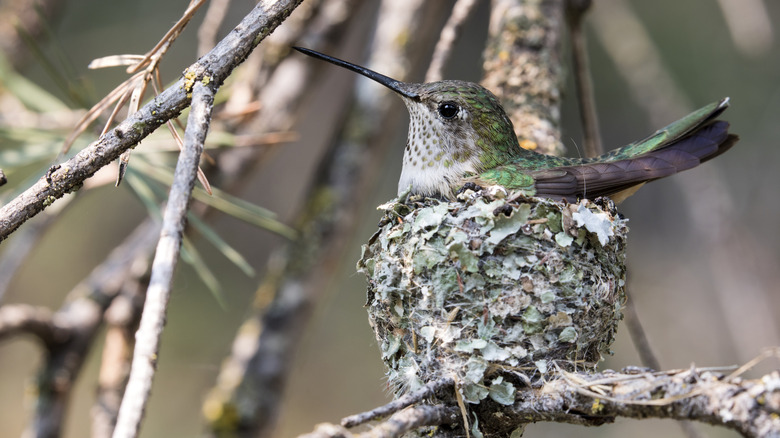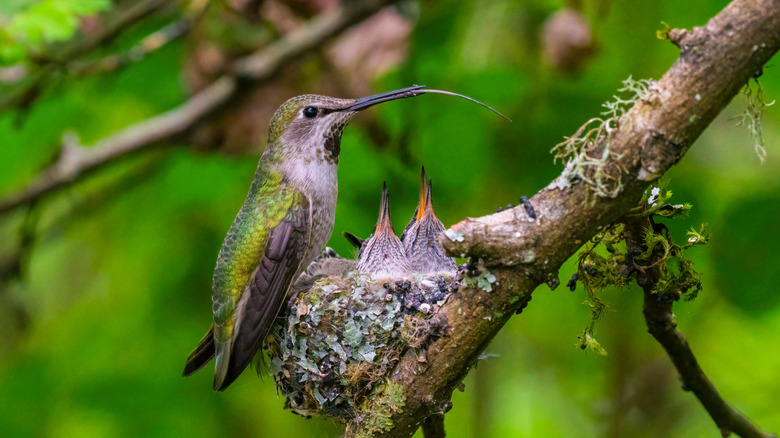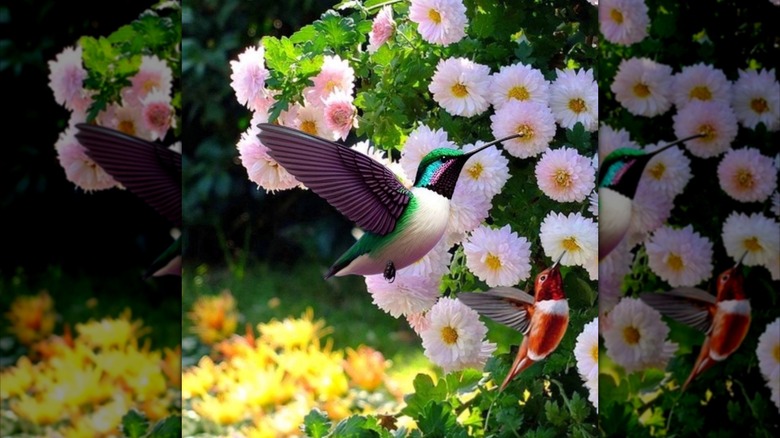How To Encourage Hummingbirds To Nest In Your Yard
We may receive a commission on purchases made from links.
Peppering your yard with nectar-rich flowers, misters, and sugar feeders will surely grab the attention of hummingbirds priming themselves for their long-drawn migration or returning from it. But does it effectually lure them to quit their house hunting, weave their walnut-sized homes somewhere in your yard, and then start laying eggs? Perhaps not! Encouraging hummingbirds to nest in your yard requires a fair bit of planning, starting from understanding their ranges, habits, nesting timings, and habitat requirements. Once you've done so, you can try to provide the hummingbirds their preferred nesting conditions (as well as the right shrubs, trees, and flowers) to encourage them to stay in your garden.
To put this into perspective, you'll likely only find ruby-throated hummingbirds actively staking and picking spots east of Mississippi to rear their families — and only during the spring. The west side, though, is spoiled for choice with broad-billed and black-chinned hummers actively nesting during April while Anna's and broad-tailed hummingbirds kickstart their routines in November. This provides year-round opportunities to convince at least one of the agile species to stay back, concept, build, and camouflage their nests right in your yard.
Rejigging your landscaping to encourage nesting hummingbirds is a futile exercise if your area borders or worse, falls outside their range. But if your yard enjoys the sweet intersectional spot, you might want to spruce things up by growing nest-building native plants for a sustainable approach to attracting hummingbirds.
Ensure your yard offers hummingbirds perches and shelter
Although there's no dearth of eclectic hummingbirds, especially amongst Anna's and ruby-throated, who wouldn't miss a wingbeat in turning your wind chimes, mobiles, plant hangers, or wires into their petite habitat when food and water sources abound, most others are quite fussy. This means to coax them to nest in your landscape, you'll have to provide them with tall shrubs, vines, and trees that can easily conceal their and their eggs' presence from predators that could be eating hummingbirds in your yard and nature's fury (think gales, rain, or sleet). Not to mention, these types of plants also serve as resting perches where the tiny dynamos scan the territory for future risks.
However, hummers have their preferences, both in the type of trees and their heights. For instance, Anna's hummingbirds favor lateral branches of sycamores, eucalyptus, or poison oaks over conifers to plait their homes and usually settle between 6 and 20 feet above ground. In contrast, broad-tailed hummingbirds would rather take cover in conifers, such as spruces, pines, and firs, in addition to cottonwoods, alders, and aspens, reaching as high as 13 feet. Choosing to shelter at heights ranging from 10 to 40 feet, ruby-throated hummers harbor in birch, pine, oak, or hackberry trees. Costa's hummingbirds stick to low-growing shrubs (sometimes as low as 3 feet), such as yucca and cactus, located in open areas for breeding.
Confirm food, water, and nesting materials are in place
To be extra certain that hummingbirds will flock to the nest-building plants in your garden, it's equally necessary they be given access to a consistent food supply — preferably from nectar-rich flowering plants, though they'll respond to feeders as well. Also, include insect-pollinated plants in your garden, as hummingbird babies mostly feed on these tiny bugs and critters until they're ready to fly out. So, you want to steer clear of spraying pesticides in your yard, too. Another element most hummers prize is a water source, as it helps moderate the area's temperature while also offering the birds a ready spring to bathe and preen their feathers. Indeed, black-chinned hummingbirds prefer starting their families in canopy trees looming over creek beds.
Although not necessary, offering nesting material can lure hummingbirds into nesting in your yards. While it can certainly take the form of ready-made commercial nesting materials (available on Amazon for about $16), you can grow yours, too. Hummingbirds often weave in plant down and bud scales in their nests, which they usually lift from thistle, cattails, dandelions, or willow shrubbery. They also appreciate the plant fibers of cinnamon fern and pussy willow as nest lining, as well as spider webs and leaf litter, so leave those in your yard — at least during the nesting season. Each year, pay attention to the migratory journeys of the hummingbirds found in your area to have the best chance of getting them to stay.


